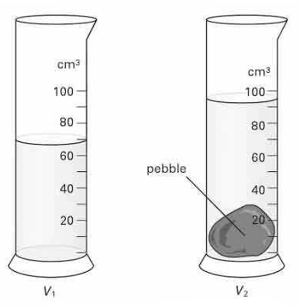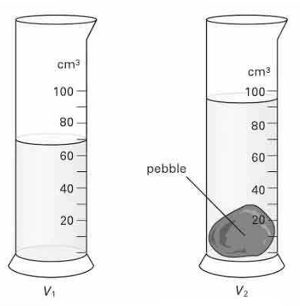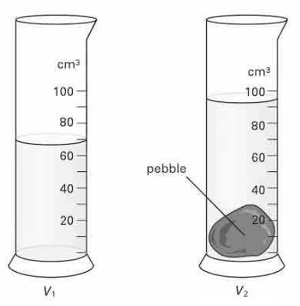An student thinks it may be possible to identify different rocks and by measuring their densities. She uses an electronic balance to measure the mass of each sample and uses the 'displacement method' to determine the volume of each sample. The diagram shows her displacement results for sample . State the volume shown in each measuring cylinder.


Important Questions on Making Measurements
An student thinks it may be possible to identify different rocks and by measuring their densities. She uses an electronic balance to measure the mass of each sample and uses the 'displacement method' to determine the volume of each sample. The diagram shows her displacement results for sample . Calculate the volume of the rock sample .

An student thinks it may be possible to identify different rocks and by measuring their densities. She uses an electronic balance to measure the mass of each sample and uses the 'displacement method' to determine the volume of each sample. The diagram shows her displacement results for sample .
Sample has a mass of . Calculate its density.

An student thinks it may be possible to identify different rocks and by measuring their densities. She uses an electronic balance to measure the mass of each sample and uses the 'displacement method' to determine the volume of each sample. The diagram shows her displacement results for sample .

The table shows the student's readings for samples and .
| Sample | |||||
Copy and complete the table by inserting the appropriate column heading and units, and calculating the densities.
A flask with a tap has a volume of .
When full of air, the flask has mass of .
The flask is connected to a vacuum pump, the air is pumped out and then the tap is closed.
The flask now has a mass of .
Calculate the mass of the air in the flask before connecting to the vacuum pump, in .
A flask with a tap has a volume of .
When full of air, the flask has mass of .
The flask is connected to a vacuum pump, the air is pumped out and then the tap is closed.
The flask now has a mass of .
Calculate the density of the air in the flask.
The volume of a stone is to be found using the equipment illustrated.
Describe how the volume of the stone is found. Copy and complete the sentences by adding appropriate words. Pour some _____ into the measuring cylinder.
The volume of a stone is to be found using the equipment illustrated.
Describe how the volume of the stone is found. Copy and complete the sentences by adding appropriate words. Take the reading of the _____ from the scale on the measuring cylinder.
The volume of a stone is to be found using the equipment illustrated.
Describe how the volume of the stone is found. Copy and complete the sentences by adding appropriate words. Carefully put _____ into the measuring cylinder.


